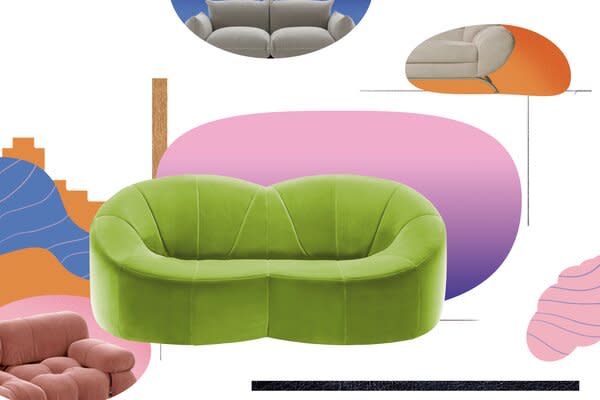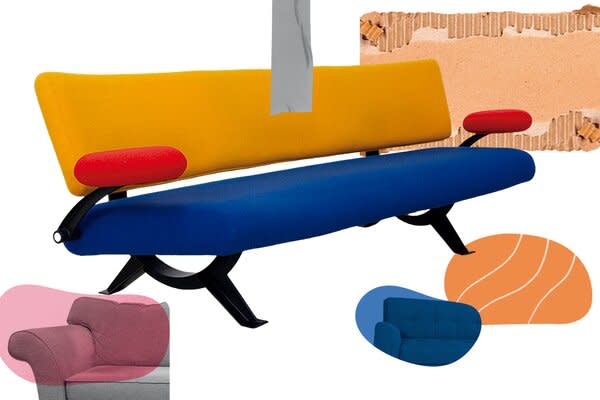Why Are (Most) Sofas So Bad?
The most important piece of furniture in your home is in need of assistance. How did we end up here? And how can we fix it?

"Don’t even bother," the upholsterer told me. I was on the phone, asking for a theoretical quote to reupholster a five-year-old or so midrange sofa, which cost more than $1,000 when new. That task, the upholsterer told me, would run me several times more than the couch was originally worth, and, owing to its construction, it was now worth nowhere near its sale price. The upholsterer proceeded to lecture me, in a helpful, passionate, and sometimes kindly manner, about how sofas made in the past 15 years or so are absolute garbage, constructed of sawdust compressed and bonded with cheap glue, simple brackets in place of proper joinery, substandard spring design, flimsy foam, and a lot of staples.
Until recently, people had no reason to suspect that a $1,200 sofa would be anything less than high quality; the vast majority of the stuff in stores was fairly well made, and you could sit on it to test it. Today, not so much. Instead of going to a furniture or department store, says Sami Reiss, a journalist and Dwell contributor who operates Snake, a newsletter about furniture design, modern consumers "are buying a couch online that looks four times as good, costs two times the price, and is made twenty times more poorly." A combination of factors, including world-altering shifts in labor, manufacturing, transportation logistics, and middle-class American aesthetics, has created a grim scene: a two-year-old, $1,200 Instagram sofa—busted, on the curb, waiting for the large-item trash pickup or an enterprising scavenger who doesn’t realize just how shitty this thing is.
Traditionally, North Carolina is the seat of the American furniture industry. Marcus Houston, the senior vice president of client growth and development at shipping strategist Transportation Insight, is based in the western part of the state. This region includes the city of High Point, which calls itself the furniture capital of the world. High Point and surrounding towns are a hub for construction, assembly, and even sales, and the area is home to High Point Market and Furnitureland South, the world’s largest furniture store. "I’ve seen a lot of change over the last fifteen years as it relates to the specific furniture vertical. All the suppliers to the industry have been here for a hundred years," says Houston. Today, the industry has spread out across multiple continents, with more products, and more philosophies, than ever before. Instead of a retail business with domestic construction and shipping performed by specialists, we’ve got drop shipping in containers from Southeast Asia, venture capital funding for Instagram photography, and, perhaps most distressingly, some really poorly made sofas.
There are absolutely sturdy, beautifully made sofas constructed in the United States. There are custom designer pieces made here or in France or Italy or Scandinavia, which tend to be prohibitively expensive for the masses. But low- and mid-priced sofas are a relatively new phenomenon, and, frankly, they often suck. A middle-class family that wanted to buy a new couch in the 1980s, for example, might have gone to a department store or a local furniture store or traveled to one of the gigantic furniture markets scattered across the country for a product that would have been designed in-house and made domestically out of good leather, dense foam, and American solid wood: oak, maple, poplar, pine.
Then, importantly, it would have been wrapped up and shipped via a specialist. "Fifteen years ago, you had to ship that on a furniture carrier, because when they finished the sofa, at a facility in Mississippi or North Carolina or something like that, they only trusted a furniture carrier to know how to blanket-wrap it, set it on there, and then they’re gonna move it throughout the country that way," says Houston. This was a slow, expensive, and delicate operation, requiring skilled labor and purpose-built materials.
The big change in shipping logistics came when furniture manufacturers developed new ways of deconstructing and flat-packing their product, allowing sofas to be shipped via regular carriers, both more cheaply and more quickly. This innovation opened up new avenues for penny-pinching. Favorable tax situations, cheap labor, and a surging wood and wood-type-product industry in Asia made it suddenly very inexpensive to construct furniture there, and those new shipping tactics made transportation feasible.
Starting in the late 1990s, according to the Bureau of Labor Statistics, the number of Americans in the furniture-manufacturing industry plummeted, from nearly 700,000 in the year 2000 to below 500,000 just before the economic crash in 2008. After that, things only got worse: Today, they’re down at around 350,000—half the industry gone in two decades. Really great furniture is still out there, but labor is more expensive and harder to find, as are some of the raw materials. To fill its place is stuff that costs what a good sofa used to cost—but without the good part.
Designs changed to accommodate the new location, new costs, and new workers. Wood was replaced with compressed wood, a wood-adjacent product made from sawdust, wood chips, and scrap and glued into the shape of a board, kind of like a McRib.
Manufacturers realized they could cut all kinds of corners, from materials to process. One of those is a technique called "eight-way hand-tying," a method of attaching individual seating coils together and to the frame of a sofa for support, usually using twine. (The eight ways: front to back, side to side, and diagonally in each direction.) It’s a time-consuming process that requires training, but serious furniture folks love it: It allows for only the springs you sit on to mold around your body, without altering the position of the rest of the suspension—like a hammock, Houston says.
In place of traditional joinery, backs and arms are attached to bases with brackets, which the consumer can assemble at home. The results of these changes are tangible: a lighter, flimsier sofa with maybe some wobble in the arms and legs, too stiff to sit on or lacking in support.
This development created Wayfair-type sofas at absurdly cheap prices, a category that didn’t really exist before. It also forced the middle-tier manufacturers to start cutting corners as well, since their labor pool was shrinking and becoming more expensive. But it did not lead to a cheaper price for these middle-tier products. Today’s $1,000 sofa is not in the same league of construction as a $299 Sears sofa (about $1,100 today) from 1980. That thing was made of actual wood.
So where are these profits going? Not to the low-cost labor in Vietnam. Not toward the materials or the shipping. "If you’ve figured out a good way to market and target the consumer and you become that marketing machine, that’s where the margin’s at," says Houston. "I’ve seen the P&L [parts and labor costs] and I saw what they paid us [in shipping], and then you see what it’s sold for, and it’s like, wow."
See the full story on Dwell.com: Why Are (Most) Sofas So Bad?
Related stories:




